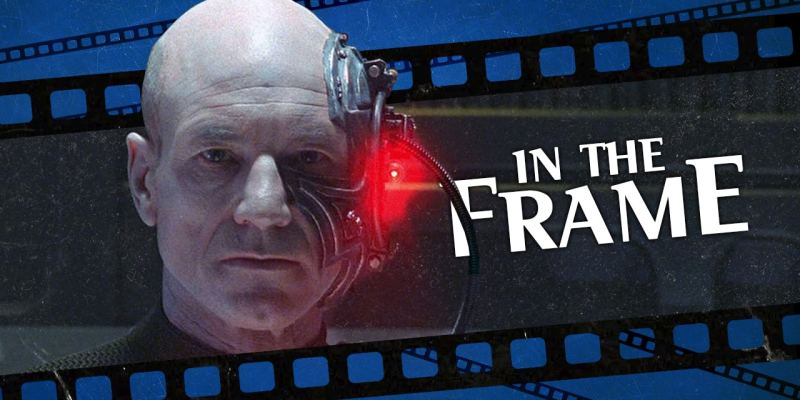It’s one of the great television moments.
Commander William T. Riker (Jonathan Frakes) stands on the bridge of the Enterprise. Standing on screen is the Borg drone, the man who was once his commanding officer, Captain Jean-Luc Picard (Patrick Stewart). The Borg are heading to Earth, planning to harvest technology and culture. The only thing standing between humanity and this existential threat is the superweapon that the Enterprise crew have developed. The catch? Destroying the Borg Cube will kill Picard.
Ron Jones’ score starts to build. Lieutenant Worf (Michael Dorn) and Counselor Deanna Troi (Marina Sirtis) look to Riker to make his decision. The camera cuts to Riker, standing beside Commander Elizabeth Shelby (Elizabeth Dennehy). Shelby is also looking at Riker. The camera arcs around to squeeze Shelby out of the shot. Riker is on his own. “Mister Worf,” he begins. “Fire.” From Riker’s face, the camera cuts to black. The score hits a crescendo. The words “To be continued…” appear.
In June 1997, TV Guide picked this episode of Star Trek: The Next Generation, “The Best of Both Worlds,” as one of the best 100 episodes of television ever made. In 2008, Empire singled out “The Best of Both Worlds, Part II” as the best episode of Star Trek: The Next Generation. In September 2016, The Washington Post suggested that the episode might have “the greatest cliffhanger in television history.” The cliffhanger of the 100th episode of Family Guy included a nod to it, down to getting Ron Jones to emulate his original score.
In hindsight, “The Best of Both Worlds” is recognized as one of the best episodes of Star Trek ever produced. It was frequently recommended in lists of “essential” episodes before Star Trek: Picard. However, three decades removed from the original broadcast of “The Best of Both Worlds,” the significance of the episode has perhaps been obscured. “The Best of Both Worlds” wasn’t just a fantastic piece of television. It was also the moment that The Next Generation came into its own.

Paramount decided to launch a live-action Star Trek spin-off following the success of the fourth feature film starring the original cast, The Voyage Home. William Shatner and his colleagues were getting too old (and too expensive) to continue to carry the franchise, so a new television series would expand the Star Trek brand, populated by new characters set roughly a century after the events of the ’60s television show.
Fans were initially hostile to the idea of a new Star Trek show, let alone one that was radically different from what came before. “The fans hated the fact that we were on,” recalled Sirtis. “They wanted their Kirk, Spock, and Bones Star Trek,” explained Frakes. Picard showrunner Michael Chabon summarized his own feelings towards the early Next Generation, “I kind of hate-watched it — although we didn’t have that term then — for most of the first season.”
Some of this was earned. The first two years of The Next Generation were turbulent, as explored in the documentary Chaos on the Bridge. There were derivative episodes like “The Naked Time” or “Home Soil.” There were bad episodes like “Up the Long Ladder” or “Shades of Gray.” There were sexist episodes like “Angel One” and racist episodes like “Code of Honor.” Brent Spiner would later joke that “it was fortuitous that we did our worst that early on and it never got quite that bad again.”
There were good episodes scattered across those first two years. “Heart of Glory” set up an arc with the Klingons that played out across The Undiscovered Country, Deep Space Nine, and Discovery. The Borg were introduced in “Q Who?” The series had its first truly great episode with “The Measure of a Man,” in which Commander Data (Spiner) is put on trial to determine his rights. Episodes like “A Matter of Honor” and “The Emissary” worked well enough.

However, it wasn’t until the third season that The Next Generation became consistently good. Even then, it was the result of behind-the-scenes chaos. Producer Michael Wagner had been brought in to fix the show but left after four episodes. Producer Michael Piller found himself thrown into the role of showrunner. A veteran television writer, Piller had no prior history with Star Trek and inherited a show in upheaval. Where others would have sank, Piller soared.
Short on scripts, Piller picked up a speculative script from a young writer named Ronald D. Moore. This was such a success that Piller opened the show to submissions from writers who may not have an agent. By the end of the season, Piller had recruited another young writer through this method, René Echevarria. Piller also brought on his friend Ira Steven Behr to help polish the scripts. Piller, Moore, Echevarria, and Behr were all major parts of the golden age of Star Trek that would follow.
Piller’s big innovation in the third season of The Next Generation was to push for character-driven plotting. Under Piller, every episode had to relate to a member of the primary cast in some significant way. This, in turn, made The Next Generation a more complex and compelling show. Moore recalled, “Michael’s emphasis on doing more character work inevitably started to push the show in directions that would keep the continuity tighter and almost started mini story arcs going.”
As a result, the show built momentum. “Yesterday’s Enterprise,” “The Offspring,” and “Sins of the Father” may be the three finest consecutive episodes of Star Trek ever produced. It was not easy. “Yesterday’s Enterprise” was rewritten by the staff over Thanksgiving to hit a deadline. “That pissed everyone off to no end,” reflected Behr. “But that was the job.” Half the writing staff would quit, insulted after Piller sent a particularly brisk memo about instructions for writing for television.

Still, it all paid off in “The Best of Both Worlds.” The episode is not the first two-parter in the history of Star Trek, although “The Menagerie” was famously just a framing device to incorporate footage from the original unaired pilot “The Cage” rather than an event of itself. Likewise, the first season finale, “The Neutral Zone,” had teased developments for the following year, but was not a direct cliffhanger. “The Best of Both Worlds” was something new for Star Trek. It was an event.
“The Best of Both Worlds” featured the arrival of the Borg, teased in both “The Neutral Zone” and “Q Who?” The Borg may be The Next Generation’s greatest addition to the Star Trek mythos, the only new species to have a comparable cultural impact to classic Star Trek aliens like the Klingons. That the Borg could carry the cliffhanger was proof The Next Generation had come into its own. The Borg would anchor the Next Generation cast’s second feature, First Contact, and the spin-off, Picard.
However, “The Best of Both Worlds” doesn’t just work because of continuity. Indeed, the Borg would arguably become tired and played out in the later seasons of Voyager, as much an embodiment of franchise fatigue in “Endgame” as they had been avatars of success in “The Best of Both Worlds.” It works because it is a culmination of Piller’s new approach to The Next Generation over the season leading into it. Notably, “The Best of Both Worlds” was entirely Piller’s project.
Moore explained, “It was the only show that year that we didn’t actually sit in the room as a writing staff and break together. Michael said he wanted to go do it.” Future writer Brannon Braga first met Piller in the gap between seasons, when Piller was still working on the cliffhanger resolution alone. Piller conceded, “I’m trying to figure out how to beat the Borg. I have no idea how to do it.” More than most of his work on the Star Trek franchise, “The Best of Both Worlds” was a personal story for Piller.

Despite the epic scale of the two-parter, “The Best of Both Worlds” is anchored in the character of William T. Riker. The first episode finds Riker procrastinating after being offered a new command, reluctant to leave the comforts of his role on the Enterprise. However, events conspire to force Riker into the role that he doesn’t want. “The Best of Both Worlds” is ultimately that archetypal coming-of-age story about a boy who needs to (metaphorically or literally) kill his father figure to become a man.
This was a personal story for Piller. At the end of that season, he was facing a choice. Would he stay where he was comfortable or leave to pursue other career opportunities? He joked, “I wasn’t planning to come back the following year, so all I had to do was write Part One, and it would be somebody else’s problem to write Part Two.” That doubt informs the characterization of Riker in “The Best of Both Worlds,” grounding the story in something relatable and human.
Star Trek: The Next Generation could not have convincingly constructed a story this sophisticated or compelling even a year earlier. Thirty years after it originally aired, “The Best of Both Worlds” remains a televisual triumph. It was the moment that The Next Generation announced itself as a force to be reckoned with. It is a sweeping story that places the future of mankind in the balance, yet pivots on a much more intimate character arc. In that sense, it truly is the best of both worlds.
